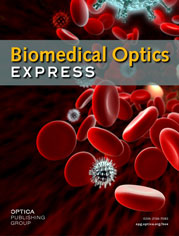Feature issue of Biomedical Optics Express
Progress in Multimodal En-Face Imaging
Submission Opens:15 August 2018
Submission Deadline: 15 September 2018
Biomedical Optics Express welcomes submissions to a feature issue on "Progress in Multimodal En-Face Imaging". Multimodal optical imaging certainly enriches the amount of information that can be retrieved from biological tissue. For this purpose, many different approaches have been combined, including optical coherence tomography (OCT), microscopy, scanning laser ophthalmoscopy (SLO), fluorescence imaging, multi-photon imaging, Raman spectroscopy, photoacoustics, and many more.
This year marks 20 years from the publication of a first report on a combination of the old SLO, dating back from 1980, and of OCT, at that time a rather novel imaging technique as it was just invented in 1991. What initially looked difficult to achieve, a simultaneous display of a contiguous SLO image, tolerant to curvature at the back of the eye and of a thin, fragmented en-face OCT image was proven possible. The en-face display of a thin section of the eye together with its SLO counterpart opened new diagnostic avenues. Apart from providing mostly complementary data, the combination of methods additionally provides the opportunity for motion correction, as different imaging planes are usually recorded with different speeds.
An additional aspect is that many structures are best viewed in the en-face plane. One example is the cone and rod photoreceptor mosaic of the retina recorded with adaptive optics (AO)-assisted imaging methods. The regularity of the mosaic is mainly revealed in this imaging plane.
Vascular imaging represents another example where only the en-face display reveals tissue-specific patterns and disease-related loss of perfusion. Thereby, OCT angiography (OCTA), triggered by progress in OCT acquisition speed, has gained increasing interest within the last few years as vasculature can be visualized without the administration of contrast agents.
To acknowledge the high activity in the field as well as to mark 20 years of engineering creativity in the field of multimodal and en-face imaging and the spark of clinical drive that progressed towards the combination of diverse modalities we enjoy today, papers are invited on the following topics:
- Combination of modalities such as confocal microscopy, nonlinear microscopy, OCT, SLO, photoacoustics, fluorescence imaging, and spectroscopic analysis for tissue imaging;
- Dual and multiple display in high-resolution imaging of eye and tissue, with emphasis on the en-face view;
- OCT angiography and corresponding signal processing;
- Advances in adaptive optics for fundus imaging and microscopy imaging;
- Detection of intrinsic signals, with en-face display and interpretation;
- Clinical advances in interpretation of high-resolution images of the eye and tissue via dual or multiple displays;
- Surgery and robotics where assistive tools use en-face imaging as one of the display modalities.
All papers need to present original, previously unpublished work, and will be subject to the normal standards and peer-review process of the journal. The standard Biomedical Optics Express Article Processing Charges will apply to all published articles.
Please prepare manuscripts according to the author instructions for submission to Biomedical Optics Express and submit through OSA's electronic submission system, specifying from the drop-down menu that the manuscript is for the Feature Issue on Progress in Multimodal En-Face Imaging.
Feature Editors
Adrian Podoleanu, University of Kent, UK (Lead Editor)
Joseph Izatt, Duke University, USA
Bruno Lumbroso, Centro Oftalmologico Mediterraneo, Italy
Michael Pircher, Medical University of Vienna, Austria
Richard Rosen, New York Eye and Ear Infirmary, USA
Rishard Weitz, New York Eye and Ear Infirmary, USA

